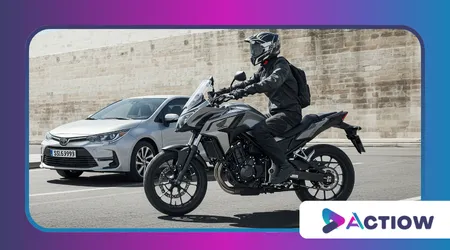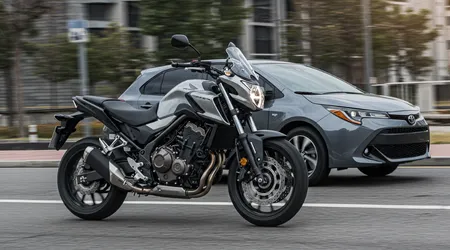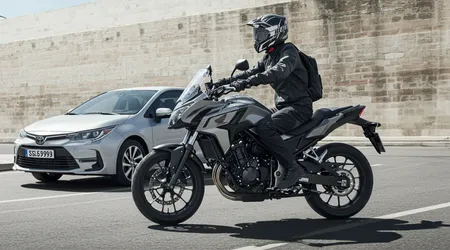Motorcycle vs. Car: Which One Saves More Money?

Anúncios
Buckle up, because the Motorcycle vs. Car debate is about to take you on a wild ride through wallets and gas tanks.
Deciding between two wheels or four isn’t just about style it’s a financial showdown. Fuel costs, maintenance, insurance, and even parking fees play starring roles in this choice.
Both options have die-hard fans swearing by their savings, but the truth lies in the numbers and real-world use.
Anúncios
Let’s peel back the layers, rev the engines, and steer through the costs to see which one truly keeps your bank account in the green.
Picture this: you’re weaving through traffic on a sleek bike or cruising comfortably in a sedan. Each paints a different money story, shaped by how you live and drive.
In 2025, with fuel prices fluctuating and urban sprawl growing, these choices hit harder than ever.
I’ll break it down with fresh data, practical examples, and a touch of gearhead wisdom because saving cash shouldn’t mean losing your spark.
Ready to dive in?
Let’s roll.This isn’t just about pennies at the pump it’s a lifestyle call with long-term stakes. Motorcycles scream freedom and efficiency, while cars promise safety and space, but at what cost?
We’re digging deep, from upfront prices to sneaky expenses like repairs, so you can decide with eyes wide open.
By the end, you’ll know which ride fits your budget and your soul, no guesswork needed.
Initial Costs: The Price Tag Face-Off
Kicking things off, let’s talk cold, hard cash the price you pay before the rubber even hits the road. A brand-new motorcycle, say a 2025 Honda CB500F, runs around $7,000, light on the wallet.
Compare that to a 2025 Toyota Corolla, starting at $22,000, and the gap’s glaring cars demand a heftier upfront chunk.
Financing a bike often means lower monthly bites, too, leaving room for other adventures.
++ Self-Driving Cars: The Future of Transportation?
Used options flip the script a bit, though bikes depreciate fast, but so do cars, depending on mileage and wear.
A solid second-hand Yamaha might cost $3,000, while a reliable pre-owned sedan hovers at $15,000. For budget hunters, Motorcycle vs. Car math leans toward two wheels here, especially if you’re dodging hefty loans.
Cash upfront sets the tone, and bikes usually win the opening lap.

Fuel Efficiency: Sipping or Gulping Gas?
Now, let’s shift gears to fuel where efficiency can make or break your savings.
Motorcycles are lean machines, averaging 50-60 miles per gallon, like the Kawasaki Ninja 400.
Cars, even efficient ones like the 2025 Hyundai Elantra at 40 MPG, often lag behind, guzzling more on daily commutes. Fill-ups sting less with a bike, especially as gas hovers near $3.50 a gallon in 2025.
Urban riders feel this edge sharper short trips and traffic jams favor a bike’s nimble sip over a car’s thirstier gulp.
Also read: Adventure Motorcycles: The Best Bikes for Long Trips
My buddy Jake, a city courier, swears his Suzuki saves him $50 monthly over his old hatchback.
Motorcycle vs. Car fuel costs tilt toward two wheels, but long highway hauls might narrow that gap cars stretch a tank further at steady speeds.
Maintenance and Repairs: Keeping the Wheels Turning
Dipping into maintenance, things get gritty both rides need love, but the bill’s a different beast. Motorcycles, with fewer parts, often mean cheaper fixes: a $100 tune-up versus a $300 car service.
Tires tell a tale, too bike pairs run $200, swapped yearly, while car sets hit $500 and last longer. Exposure to weather, though, can rust a bike faster, nudging costs up.
Read more: The Best Motorcycle Brands in 2025
Cars pile on complexity think transmissions and AC units pushing repair tabs higher when they break. AAA’s 2024 data pegs car upkeep at $0.10 per mile, bikes closer to $0.06, a quiet win for two wheels.
Motorcycle vs. Car upkeep depends on your ride style neglect either, and the savings vanish in a puff of exhaust.
Insurance: Covering Your Ride
Insurance throws another curveball into the mix premiums swing wildly based on you and your machine.
A 30-year-old with a clean record might pay $300 yearly for a bike, per Progressive’s 2025 rates, while a sedan’s coverage nears $1,200.
Less metal to crash equals lower risk, insurers say, but one wipeout on a bike can spike claims differently.
Riders like my cousin Mia, who ditched her SUV for a scooter, slashed her bill by 60%, grinning all the way. Cars, with airbags and crumple zones, sometimes offset higher rates with safety cred but not enough to close the gap.
Motorcycle vs. Car insurance leans bike-friendly, unless you’re a speed demon tempting fate.
Hidden Costs: Parking, Tolls, and More
Beyond the obvious, sneaky expenses creep in parking’s a prime suspect in crowded 2025 cities. Bikes slip into free spots or tiny lots, costing $0 to $5 monthly, while cars shell out $50 or more in urban hubs.
Tolls follow suit many U.S. states cut motorcyclists a break, halving fees cars cough up on bridges and highways.
Storage flips it, though cars hog garage space but shield groceries from rain, bikes need less room yet demand gear like helmets, adding $100 yearly.
My neighbor Tom parks his Harley curbside, smirking at my car’s parking fines. Motorcycle vs. Car hidden costs favor agility over bulk, but convenience has its price.
Longevity and Resale Value: How Long Does Your Money Last?
Peering down the road, how long your ride lasts and what it’s worth later matters big time.
Motorcycles often clock out sooner, with 50,000 miles a solid lifespan, while cars push 150,000 with care.
A $7,000 bike might fetch $2,000 after five years, but a $22,000 car could hold at $10,000, softening the depreciation blow.
Riders argue passion trumps longevity swap bikes like fashion, they say, while car folks bank on durability.
Data from Kelley Blue Book 2025 shows cars retain 45% value over five years, bikes 30%. Motorcycle vs. Car resale hinges on use daily grind favors four wheels, thrill-seekers bet on two.

Lifestyle Fit: Savings Beyond the Spreadsheet
Money’s not the whole story your life shapes the savings game, too. Single, city-dwelling adventurers thrive on bikes, dodging traffic and parking woes, pocketing extra cash.
Families hauling kids and gear lean car-wise minivans beat saddlebags for soccer runs, even if fuel bills climb. It’s practicality versus pizzazz.
Take my friend Lisa, a weekend rider she saves big keeping her bike for fun, car for work.
Hybrid lifestyles blur the Motorcycle vs. Car line, blending costs and perks. Your habits commute length, weather, cargo steer the wheel, proving savings isn’t one-size-fits-all.
The Numbers at a Glance
Let’s crunch it with two tables real costs, no fluff, based on 2025 averages for a typical rider/driver.
Table 1: Annual Costs Comparison (Urban Commuter, 10,000 Miles)
| Expense | Motorcycle | Car |
|---|---|---|
| Fuel | $350 | $875 |
| Maintenance | $600 | $1,000 |
| Insurance | $300 | $1,200 |
| Parking | $60 | $600 |
| Total | $1,310 | $3,675 |
Table 2: Initial and Long-Term Costs (5-Year Ownership)
| Expense | Motorcycle | Car |
|---|---|---|
| Purchase Price | $7,000 | $22,000 |
| 5-Year Upkeep | $3,000 | $5,000 |
| Resale Value | -$2,000 | -$10,000 |
| Net Cost | $8,000 | $17,000 |
Bikes dominate short-term, urban wins cars claw back on longevity.
Conclusion: Who Wins the Money Race?
So, which ride keeps your wallet happiest?
Motorcycle vs. Car isn’t a knockout it’s a photo finish, hinging on you. Bikes shine for solo, city souls craving low bills and high vibes $1,300 yearly versus $3,600 says it loud.
Cars fight back for families, road-trippers, or anyone needing space, trading higher costs for versatility over years.
Reflect on Jake, Mia, and Lisa they all save, just differently, proving context is king. In 2025, with smart choices, either can win bikes for agility, cars for endurance.
Test-ride your budget, weigh your life, and pick the savings that fits your throttle.
What’s your move two wheels or four?
